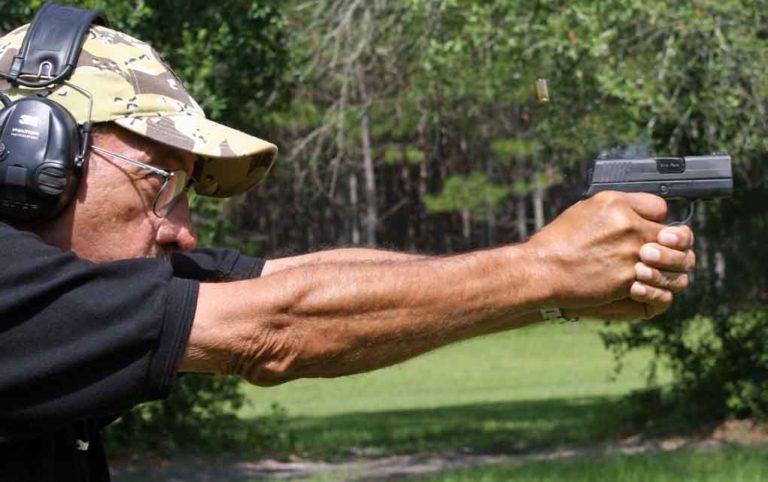
A double-action-only variation of the original P290, the SIG P290RS offers shooters a reliable and compact pistol, with the peace of mind of re-strike capabilities.
- The SIG P290RS was released in 2012, a double-action only variant of the original P290, produced to meet users' demands for re-strike capabilities.
- There are four other major redesign points on the P290RS from the original: an added beavertail, rounded slide-lock lever, trimmed down magazine release button and a lengthened lip on the magazine.
- The trigger pull is consistent on the P290RS, breaking at a predictable 9 pounds each time; however, being DAO, it is an extremely long trigger pull.
- The P290RS proved reliable in the author's testing, though due to its extremely small size, it does take time to grow accustomed to shooting the handgun.
A year after its introduction, SIG’s smallest 9mm gets some meaningful design changes.
The guns I call “slim-nines,” 9mm carry pistols made thin and ultra-compact, are a hot item today. SIG’s entry is the P290. I first saw it in the fall of 2010 at the IACP (International Association of Chiefs of Police) conference. It was introduced in January 2011 at the SHOT Show.

Some concerns showed up in its first year in the field. There were reports of occasional misfires. Because a lot of buyers were fans of traditional double-action SIG Sauer pistols, they didn’t appreciate the fact that, like so many striker-fired autos, these new guns wouldn’t let you just pull the trigger again if you got a misfire, one SIG exec later informed me. The folks at SIG Sauer in Exeter, N.H., came up with a few other tweaks that could be wrought on the P290, too.
As a result, the redesigned P290RS was introduced right at a year after the original P290, at the 2012 SHOT Show. It’s not another option, it’s a total replacement of the older gun.
Key Features
The trigger mechanism is the defining new feature — but not the only one — on the P290 RS. The suffix in its designation stands for Re-Strike. SIG Sauer’s product manager at the Exeter plant, Tim Butler, tells me that the change involved a redesign of trigger bar, sear, and hammer. The result is a long, conventional double-action-only trigger stroke. The trigger goes much farther back before sear release than on the first iteration, but has proportionally less backlash.
Raise Your Sig Sauer IQ
The obvious advantage is that it gives an immediate second “shot” at a recalcitrant primer in the event of a misfire. Some don’t see this as a big deal, because they follow the doctrine that a bad round that’s failed them once doesn’t get a second chance, and their preferred response to a “click” instead of a “bang” is a fast “tap-rack-assess the situation in front of you.”
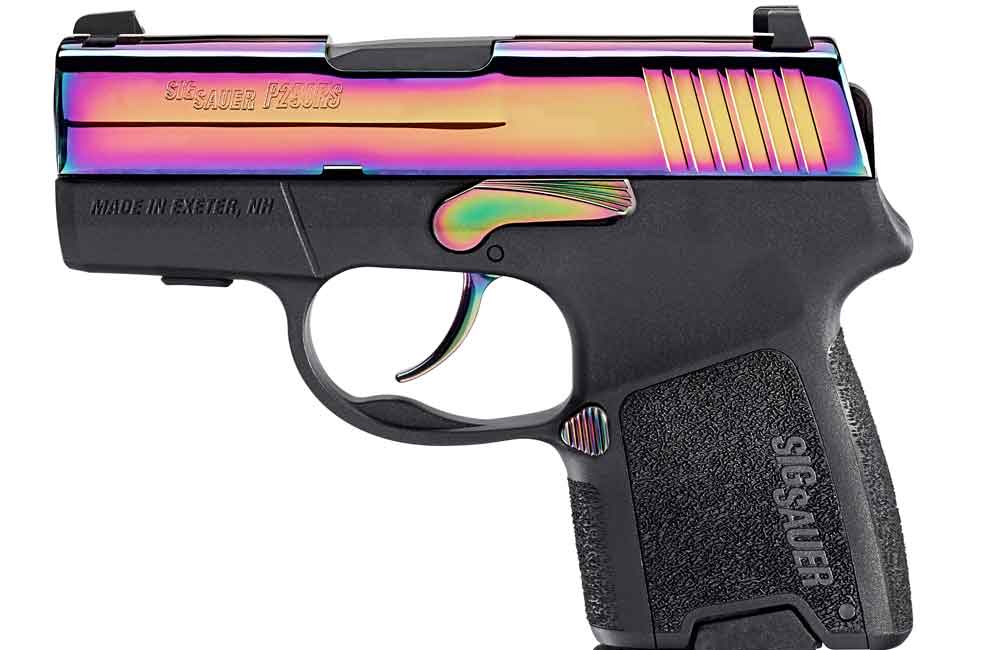
An absolutely undeniable advantage of the P290RS over its predecessor, however, is that it’s much more friendly for dry fire. Instead of having to interrupt your trigger pulling practice by breaking your hold and retracting the slide between dry “shots,” the P290RS owner can roll the trigger continuously.
There have been four other changes. Apparently some folks had hands beefy enough that the web of their palm could ride up and get pinched by the bottom of the external hammer during the slide cycle. (That never happened to this writer with the P290, but this writer doesn’t have the world’s biggest hands, either.) In any case, a subtle, rounded beavertail has been added at the rear of the grip tang. For smaller-handed shooters, it won’t hurt anything; for those with meatier paws, it could be a deal-sealer for this little 9mm.
The lower rear edge on the slide-lock lever of the earlier P290 had a rather sharp corner, and I can see where that would have been a problem for those who shoot with straight thumbs. That corner has been very nicely rounded. Good for you, SIG! There’s another manufacturer of powerful subcompact pistols which has long ignored a similar well-founded criticism.
On the first variation, the magazine release button stood up “loud and proud.” The good news was, when you were doing a speed reload, that big button was easy to hit. The bad news was, when you weren’t trying to dump the mag, it was still easy to hit. There were reports of some buyers carrying it inside their waistband, along with a personal “spare tire,” whose excess flesh accidentally popped the magazines. For the P290RS, the mag release button was trimmed down some in hopes of curing that problem.
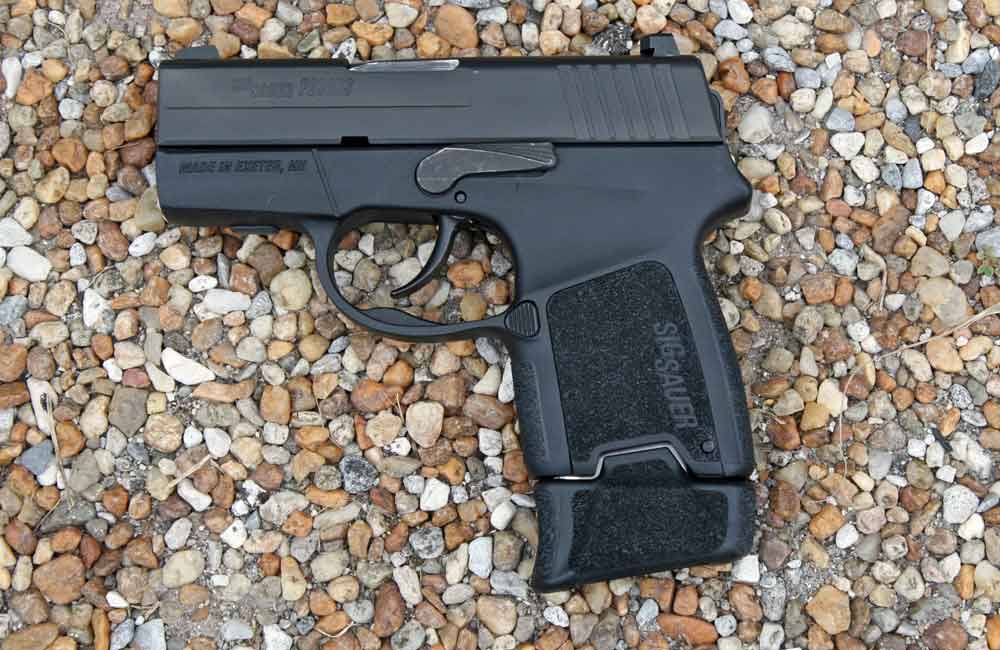
Finally, for some users, the super-small profile that was the P290’s raison d’etre proved to be too small. Those consumers felt they couldn’t get enough hand on the gun when shooting. A lengthened lip on the P290RS magazine created enough additional frontal length for both middle finger and ring finger to gain a secure purchase. (For those who want minimum butt size in every dimension, the P290RS comes with a flush-bottom floorplate that can be installed on the new magazine which, like the old, holds six rounds. Older mags will work in the new version of the P290, and vice versa.)
Moreover, the P290RS comes with an additional eight-round magazine featuring a grip extension. The thing was a test of strength insofar as getting the eighth round in, but it worked fine, and didn’t bind upon insertion, even with the slide closed.
The slide stop on the first P290 had a sharp edge at the lower rear. It is rounded on the P290RS.
Trigger pull
P290s in their first generation had a trigger pull somewhere between 9 pounds and off-the-chart, the latter referring to the fact that the most popular pull gauge hits its limit at about 12 pounds. The test P290RS when tested on a Lyman digital trigger pull gauge from Brownells averaged 9.23 pounds of pull weight, when leaving the slide forward throughout and just pulling the gauge on the trigger. However, when cocking the slide to duplicate live fire cycling between each test trigger pull, the average weight went up to 9.60 pounds of average pull.
Accuracy
Strangely enough, over the years it has become common to test short-barrel handguns at short ranges — 5, 7, 10, or 15 yards — instead of at the 25-yard line, which is where fighting handgun accuracy has been judged ever since this old man came on the scene. Not yet having “gotten the memo” that people with short-barrel hand guns will be “given a handicap” in a gunfight across a parking lot, this writer continues to test short barrel and longer-barrel defensive handguns alike at the traditional distance of 25 yards.
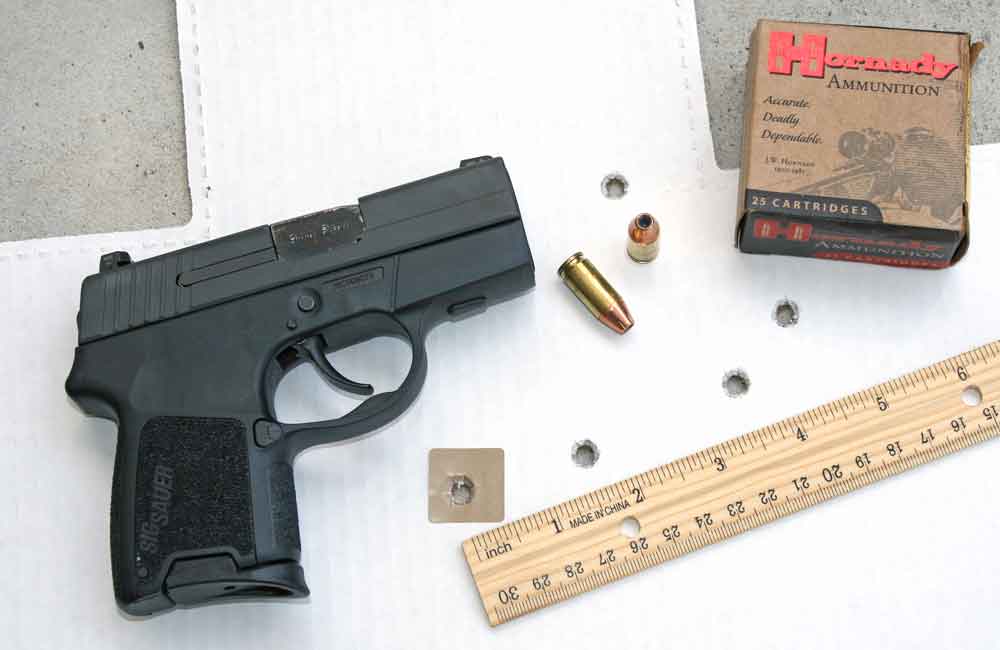
Working hand-held off a Matrix rest on a concrete bench at a measured 75 feet, I tried out the P290RS with the three most popular bullet weights in 9mm Luger/9mm Parabellum/9×19. (You know the cartridge has been around for a while when there are at least three different designations for the same darn thing.) I used my standard protocol: measuring each five-shot group center to center between the farthest hits, and then taking a second measurement of the best three hits. A test done for American Handgunner a decade ago, with me and Charles Petty, confirmed that the “best three” measurement under these circumstances would come remarkably close to what the same gun and cartridge would do from a properly adjusted Ransom machine rest. It’s a useful tool, because most folks don’t have access to a machine rest, but most of them can test their hardware from a solid bench rest, to compare their results with what the gun writer might be getting.
147-grain subsonic 9mm rounds became trendy in the late 1980s. Winchester developed the concept with their original OSM (Olin Super Match), created at the behest of Special Forces personnel who wanted super-accurate 9mm rounds that could center an enemy sentry’s head from a suppressed MP5 submachine gun. The exemplar of the concept for this test was the inexpensive Remington-UMC 147-grain full metal jacket round, which this writer has seen win many a pistol match. From the SIG Sauer P290RS, it put five shots into 4.25 inches from 25 yards. It must be noted that four of those five shots were in 2.45 inches, and the significant “best three” shots created a tight group of 1.10 inches. (Measurements were to the nearest 0.05 inch.)
For most of the epoch of the 9mm Luger cartridge, the 124-grain bullet was the heaviest load available. For this test, our 124-grain exemplar was the Hornady XTP load, using a deep-penetrating jacketed hollow point projectile. The five shots went into 4.35 inches, and the best three of those formed a 2.80-inch group.
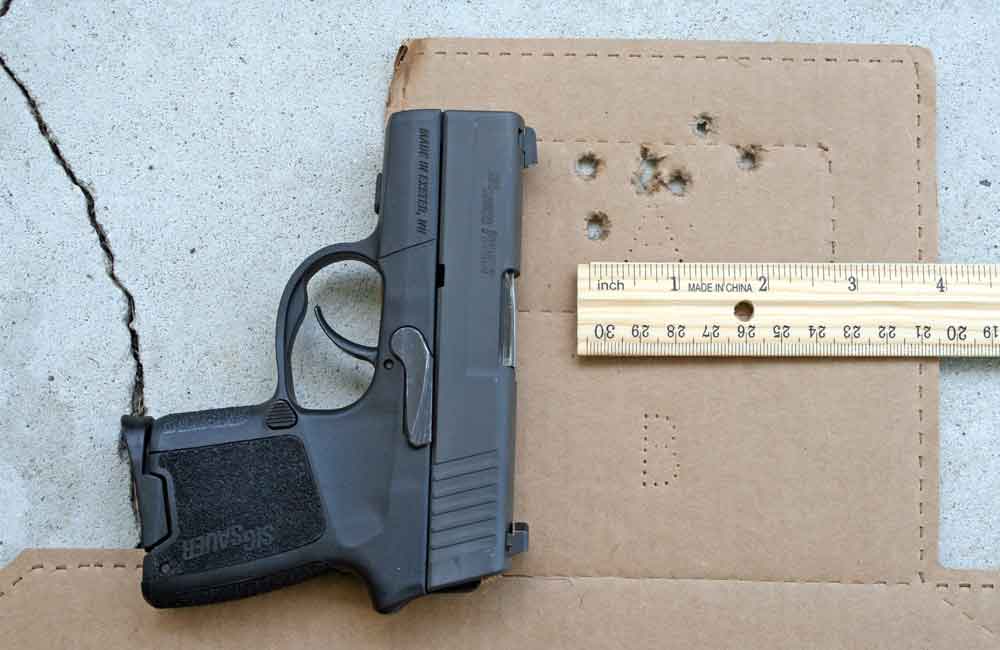
When this writer was a young puppy cop, if you wanted a hollow point 9mm round, it was going to weigh 115 grains. Our test load in that bullet weight was the Federal Classic, coded by its manufacturer as “9BP,” which over the decades proved itself to be one of the most accurate loads ever produced in its caliber. It re-proved that in this test, with a five-shot group measuring 4.05 inches. Four of those shots were a mere two and a quarter inches apart, and the “best three hits” measurement was “the best of the test,” 65/100ths of one inch center to center. That is simply amazing performance from a short barrel pocket pistol with a heavy trigger pull at, remember, 25 yards, not 25 feet.
For a very long time now, “conventional gun wisdom” has held that a 4-inch group at 25 yards was “acceptable combat accuracy” from a full-size 9mm service pistol. The P290RS, an itty bitty pocket pistol, came achingly close to that: 4.15 inches with 147 grain, 4.35 inches with 124 grain, and 4.05 inches with 115 grain averages under four and a quarter inches. By that standard, we have in the SIG P290RS a pocket-size 9mm that needs to make no apologies at all in terms of accuracy. This was, after all, a small, light gun with a long trigger pull much heavier than the gun’s own weight. I have no doubt that its intrinsic accuracy is much greater than what I was able to wring out of it in five-shot groups.
Explore Related SIG Sauer Articles:
- A Guide to the Best SIG Sauer Pistols for Concealed Carry
- Best SIG P365 Upgrades – Top Barrels, Grips & More
- SIG 516 AR-15 [REVIEWED]
- The Cold War Legacy: SIG P6 Review
- SIG M17 Review – Bridging Military and Civilian Needs
- A Head-to-Head Review: Micro 9 vs SIG P938
Shooting and carrying the P290RS
I wore the little SIG 9mm for a while on my non-dominant-side hip as a backup, in the useful new Remora holster. Comfort was exquisite: no sharp edges anywhere.
Because of the long trigger pull and concomitantly long trigger return, I wasn’t able to get the speed in rapid fire that I’d expect from some other fire control mechanisms. Recoil had a bit of a snap for 9mm Parabellum, but nothing I could call uncomfortable. The shape of the P290RS causes it to point low for me, but that’s subjective: dry handling in the gun shop will quickly show whether it’ll be a problem for you, before you put your money on the counter.
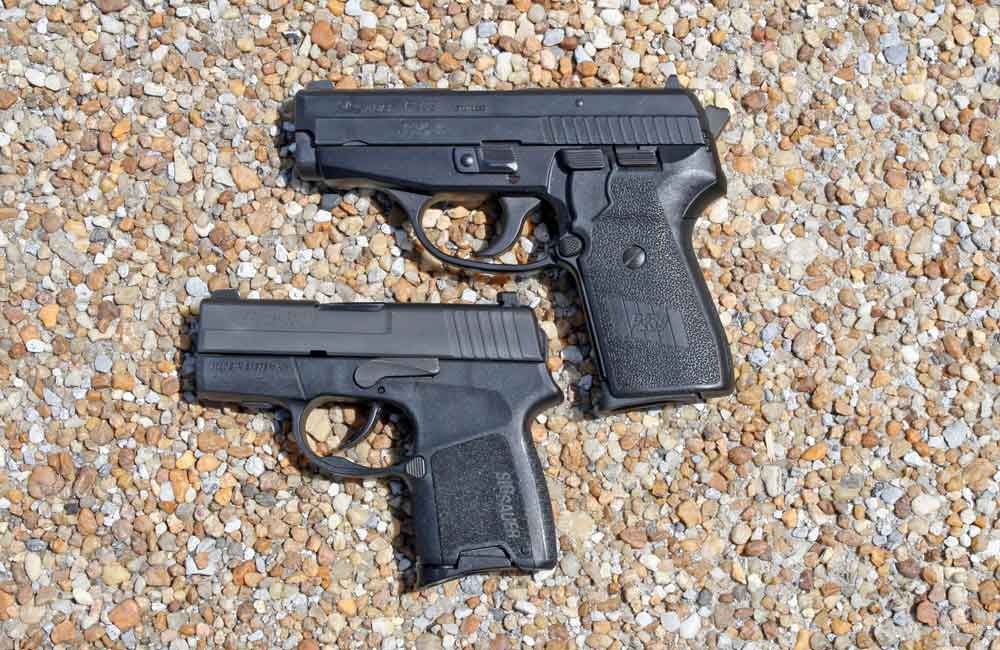
This little pistol passed through a lot of hands among my test group. Only one shooter had a problem: A man with very long fingers found his middle finger (and particularly his thumb, in the thumb-down grasp he prefers) rode the magazine release and three times caused the mag to drop when he didn’t want it to. The long, heavy trigger pull didn’t make a lot of friends, but the little SIG’s comfortable size and rounded edges were both unanimously appreciated. Several also liked the fact that by putting their thumb on its flat hammer, they could holster the P290RS without fear of an unintended discharge if a drawstring from a warm-up jacket or something like that got fouled in the trigger area.
Throughout the whole test, there were only two malfunctions. One was a 12 o’clock misfeed with a 147-grain load, quickly rectified with a tug on the slide. The other was a misfire (on a Federal round, of all things, famous for sensitive primers). As per the “RS” design, I just pulled the trigger again, and the shot went downrange. Both malfs occurred early in the first 50 shots during “break-in.” There were no further mechanical malfunctions.
All in all, despite a manufacturer’s suggested retail price of $758, this handy little 20.5-ounce seven-shooter is a definite contender in the currently hot niche of subcompact 9mm carry pistols.
Editor's Note: This article is an excerpt form The Gun Digest Book of SIG-Sauer.
Raise Your Sig Sauer IQ:
- Sig Sauer Pistols
- P225-A1
- P320
- P516
- MCX
- P220
- P320C
- 516 Patrol Rifle
- P250
- P6
- M17 Civilian Variant
- P938
- P365
- P226
- MCX Rattler
Why You Can Trust Gun Digest
Since 1944, Gun Digest has been a trusted authority on firearms, shooting and shooting gear, delivering expert firearms reviews backed by nearly a century of experience. We go beyond standard reviews, combining hands-on independent gun testing, in-depth research, and expert insights from industry professionals and manufacturers.
Our reviewers are the bedrock of our testing and come from a comprehensive cross section of the shooting world. Their diverse backgrounds include law enforcement professionals, military veterans, competitive shooters, seasoned hunters and life-long firearms enthusiasts. In addition to being firearm experts, we are also thorough journalists adhering to the strictest standards of the profession.
For our readers, this means objective, unbiased reviews, free from outside influence. Our priority is to provide the information you need to make informed decisions—whether a firearm or piece of gear is a must-have investment or one to pass on.
Find out more about our Editorial Standards and Evaluation Process

Next Step: Get your FREE Printable Target Pack
Enhance your shooting precision with our 62 MOA Targets, perfect for rifles and handguns. Crafted in collaboration with Storm Tactical for accuracy and versatility.
Subscribe to the Gun Digest email newsletter and get your downloadable target pack sent straight to your inbox. Stay updated with the latest firearms info in the industry.

![Best Concealed Carry Guns In 2025 [Field Tested] Wilson Combat EDC X9S 1](https://gundigest.com/wp-content/uploads/Wilson-Combat-EDC-X9S-1-324x160.jpg)


![Best 9mm Carbine: Affordable PCCs [Tested] Ruger Carbine Shooting](https://gundigest.com/wp-content/uploads/Ruger-Carbine-Shooting-100x70.jpg)


I love the p290RS specifically for its re-strike capability and pocket size. It still remains unmatched in the year 2024. It honestly amazes me that there are people (as mentioned in the article) who think they will hear the “click” of a failure to fire in a self defense situation and their response will be “a fast tap-rack” instead of a second trigger pull. They are, in my opinion, highly delusional. I don’t care if you are John Wick, the fact is, in a gunfight where you are hyper focused on your target and adrenaline is flowing through your veins, you will have pulled the trigger more than once on a bad round before you brain processes that tap-rack is required. By that time, the benefits of re-strike may have already solved the problem.
I love the P290RS and hate that Sig no longer offers this model. I ended up buying another used model online as it’s become one of my favorite CCW guns. I find it super easily to conceal, very easy to shoot, and very manageable. I was very surprised that the P290 and the P290RS didn’t end up being a more popular seller for Sig.
My problem with the P290RS was trying to find a leather IWB holster for it. There are kydex options, but very few nice leather options. I ended up ordering a tuckable IWB from here: http://www.gunnersalley.com/sig-sauer-p290/. I wear it AIWB and it basically disappears. According to Sig, the P365 is a replacement for the P290, but I’ll gladly take my P290RS over a 365 any day of the week.
I love my P290, I use a kydex iwb holster from Clinger Holsters.
https://clingerholsters.com/kydex-sig-p290-holsters-concealed-carry/
When the P290 can out, I wanted one to move up to 9mm from my .380. By the time I got around to buying one, the RS model was available. I am glad I waited. This is my Every Day Carry gun. I put it in a nylon holster like the Sneaky Pete and carry it openly on my hip. Much of the time, it is covered by my vests but sometimes in the open.
I have never had anyone ask about it. Once, when I was discussing Concealed Carry with a friend, he said, “I wondered what you had in the pouch.” The pouch is a little bigger than one for a cell phone but not for something like the Galaxy Note. That is as close as anyone has come to thinking I have a gun on me.
The gun shoots more accurately than me and has never malfunctioned once. Recoil is very manageable. I have fairly short, thick fingers and this gun fits me well although, I do prefer the extended magazine for regular practice shooting. When out an about, I carry it as the spare because the pouch would have to be even bigger to accommodate it.